Procedures
What is endodontic treatment?
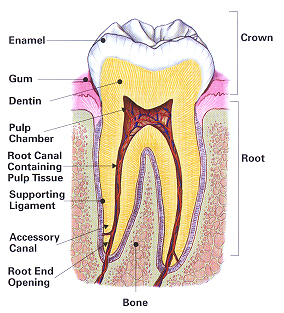
“Endo” is the Greek word for “inside” and “odont” is Greek for “tooth”. Endodontic treatment treats the inside of the tooth.
To understand endodontic treatment, it helps to know something about the anatomy of a tooth. Inside the tooth, under the white enamel and a hard layer called the dentin, is a soft tissue called the pulp. The pulp contains blood vessels, nerves, and connective tissue and creates the surrounding hard tissue of the tooth during development.
The pulp extends from the crown of the tooth to the tip of the roots where it connects to the tissues surrounding the root. The pulp is important during a tooth’s growth and development. However, once a tooth is fully mature, it can survive without the pulp, because the tooth continues to be nourished by the tissue surrounding it.
Why would I need an endodontic procedure?
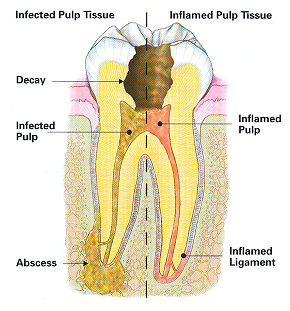
Endodontic treatment is necessary when the pulp becomes inflamed or infected. The inflammation or infection can have a variety of causes; deep decay, repeated dental procedures on the tooth, or a crack or chip in the tooth. In addition, a blow to a tooth may cause pulp damage even if the tooth has no visible chips or cracks. If pulp inflammation or infection is left untreated, it can cause pain, or lead to an abscess.
Signs of pulp damage include pain, prolonged sensitivity to heat or cold, discoloration of the tooth, and swelling and tenderness in the nearby gums. Sometimes, there are no symptoms.
How does endodontic treatment save the tooth?
The endodontist removes the inflamed or infected pulp, carefully cleans and shapes the inside of the tooth, then fills and seals the space. Afterwards, you will return to your dentist, who will place a crown or other restoration on the tooth to protect and restore it to full function. After restoration the tooth continues to function like any other tooth.
Endodontic Procedure
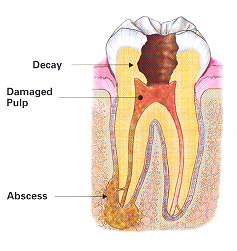
Endodontic treatment can often be performed in one or two visits and involves the following steps:
1. The endodontist examines and x-rays the tooth, then administers local anesthetic. After the tooth is numb, the endodontist places a small protective sheet called a “dental dam” over the area to isolate the tooth and keep it clean and free of saliva during the procedure.
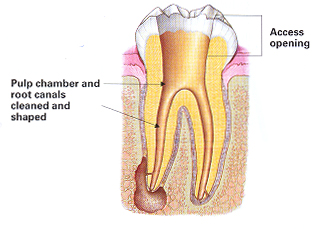
2. The endodontists makes an opening in the crown of the tooth. Very small instruments are used to clean and shape the pulp chamber and root canals, to prepare the canals for filling.
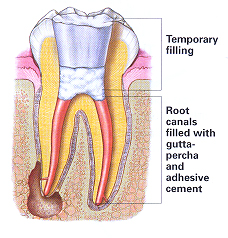
3. After the space is cleaned and shaped, the endodontist fills the root canals with a biocompatible material, usually with a rubber-like material called “gutta-percha” The gutta-percha is placed with an adhesive cement to ensure complete sealing of the root canals. In most cases, a temporary filling is placed to close the opening. The temporary filling will be removed by your dentist before the tooth is restored.
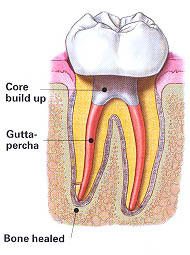
4. After the final visit with your endodontist, you must return to your dentist to have a crown or other restoration placed on the tooth to protect and restore it to it’s full function. If the tooth lacks sufficient structure to hold the restoration in place, your dentist or endodontist may place a post inside the tooth. Ask your dentist or endodontist for more details about the specific restoration planned for your tooth.
